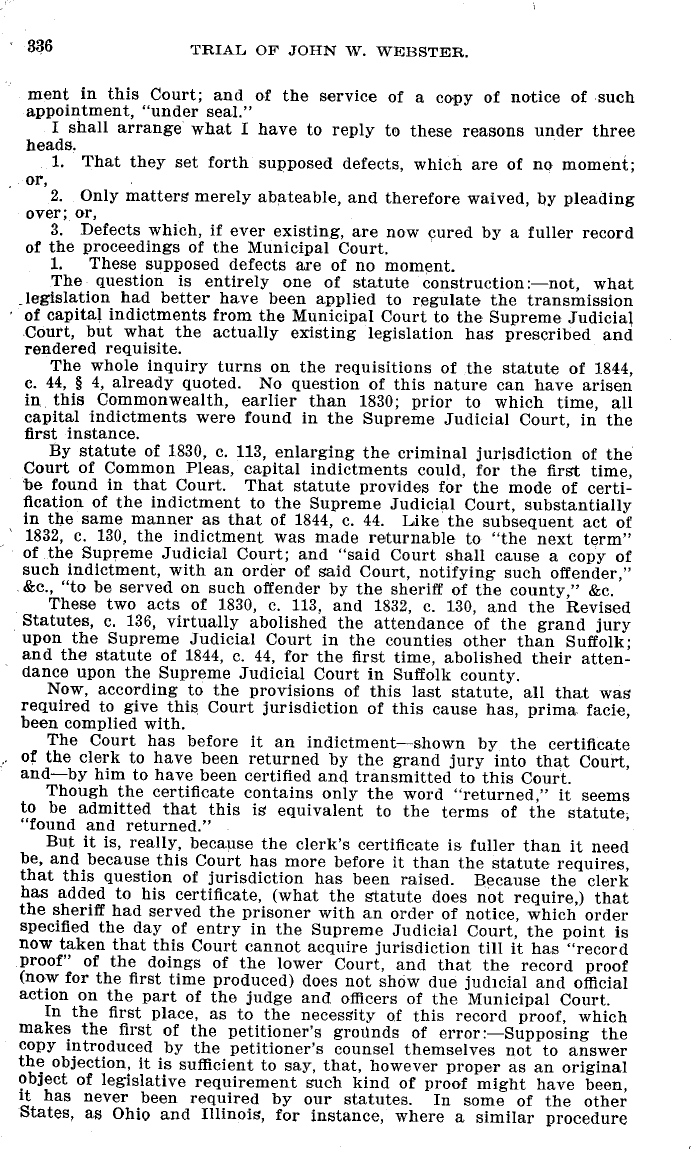|
336 TRIAL OF JOHN W. WEBSTER.
ment in this Court; and of the service of a copy of notice of such
appointment, "under seal."
I shall arrange what I have to reply to these reasons under three
heads.
1. That they set forth supposed defects, which are of no moment;
or,
2. Only matters merely abateable, and therefore waived, by pleading
over; or,
3. Defects which, if ever existing, are now cured by a fuller record
of the proceedings of the Municipal Court.
1. These supposed defects are of no moment.
The question is entirely one of statute construction: not, what
-legislation had better have been applied to regulate the transmission
of capital indictments from the Municipal Court to the Supreme Judicial
Court, but what the actually existing legislation has prescribed and
rendered requisite.
The whole inquiry turns on the requisitions of the statute of 1844,
c. 44, § 4, already quoted. No question of this nature can have arisen
in this Commonwealth, earlier than 1830; prior to which time, all
capital indictments were found in the Supreme Judicial Court, in the
first instance.
By statute of 1830, c. 113, enlarging the criminal jurisdiction of the
Court of Common Pleas, capital indictments could, for the first time,
be found in that Court. That statute provides for the mode of certi-
fication of the indictment to the Supreme Judicial Court, substantially
in the same manner as that of 1844, c. 44. Like the subsequent act of
1832, c. 130, the indictment was made returnable to "the next term"
of the Supreme Judicial Court; and "said Court shall cause a copy of
such indictment, with an order of said Court, notifying such offender,"
&c., "to be served on such offender by the sheriff of the county," &c.
These two acts of 1830, c. 113, and 1832, c. 130, and the Revised
Statutes, c. 136, virtually abolished the attendance of the grand jury
upon the Supreme Judicial Court in the counties other than Suffolk;
and the statute of 1844, c. 44, for the first time, abolished their atten-
dance upon the Supreme Judicial Court in Suffolk county.
Now, according to the provisions of this last statute, all that was
required to give this Court jurisdiction of this cause has, prima facie,
been complied with.
The Court has before it an indictment-shown by the certificate
of the clerk to have been returned by the grand jury into that Court,
and-by him to have been certified and transmitted to this Court.
Though the certificate contains only the word "returned," it seems
to be admitted that this is equivalent to the terms of the statute;
"found and returned."
But it is, really, because the clerk's certificate is fuller than it need
be, and because this Court has more before it than the statute requires,
that this question of jurisdiction has been raised. Because the clerk
has added to his certificate, (what the statute does not require,) that
the sheriff had served the prisoner with an order of notice, which order
specified the day of entry in the Supreme Judicial Court, the point is
now taken that this Court cannot acquire jurisdiction till it has "record
proof" of the doings of the lower Court, and that the record proof
(now for the first time produced) does not show due judicial and official
action on the part of the judge and officers of the Municipal Court.
In the first place, as to the necessity of this record proof, which
makes the first of the petitioner's grounds of error:-Supposing the
copy introduced by the petitioner's counsel themselves not to answer
the objection, it is sufficient to say, that, however proper as an original
object of legislative requirement such kind of proof might have been,
it has never been required by our statutes. In some of the other
States, as Ohio and Illinois, for instance, where a similar procedure
|

